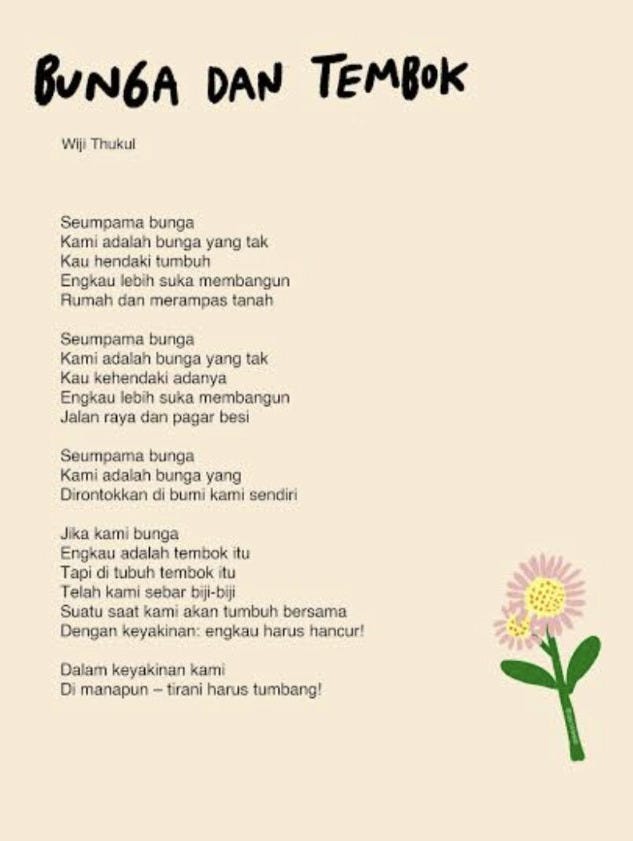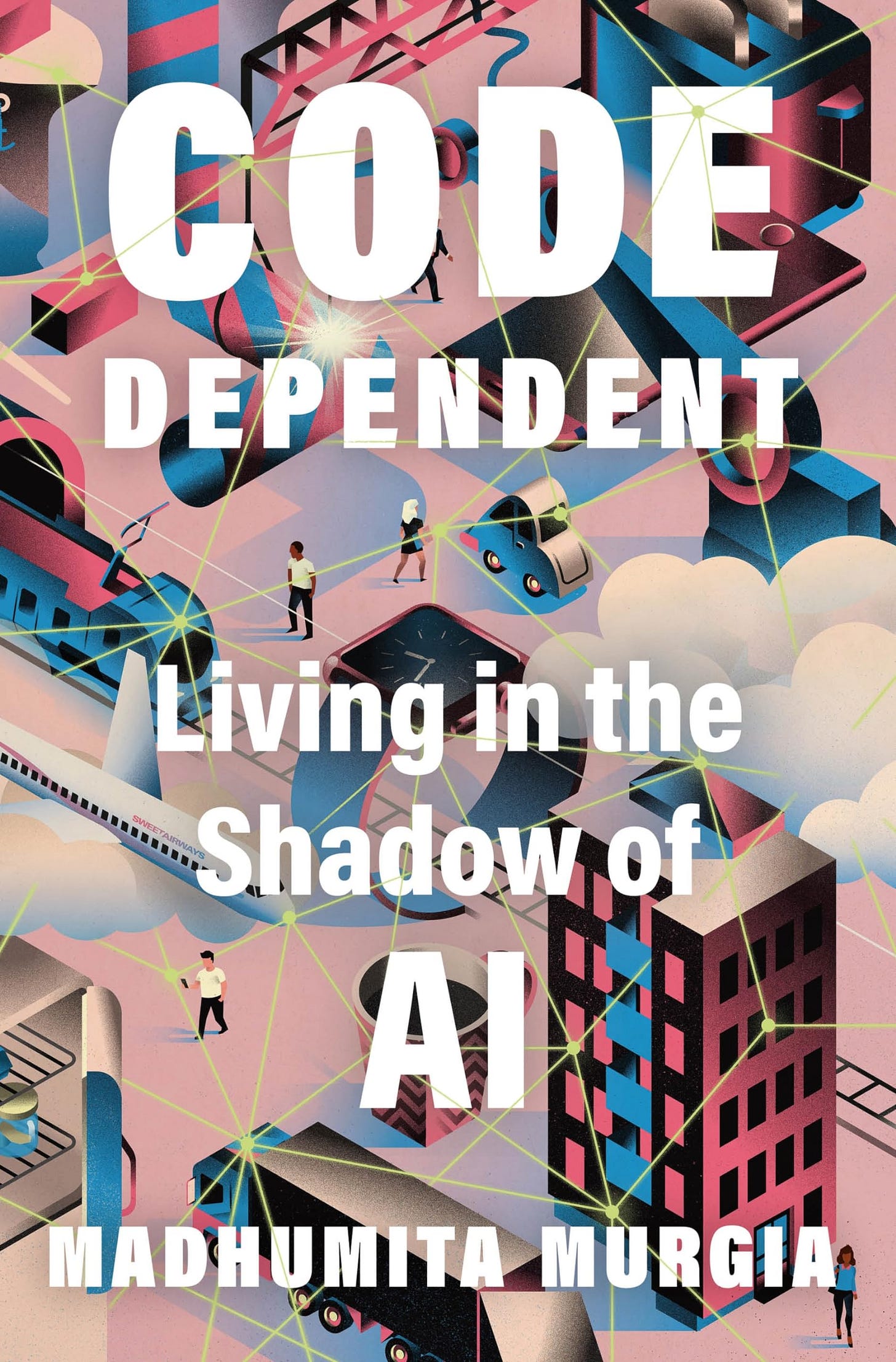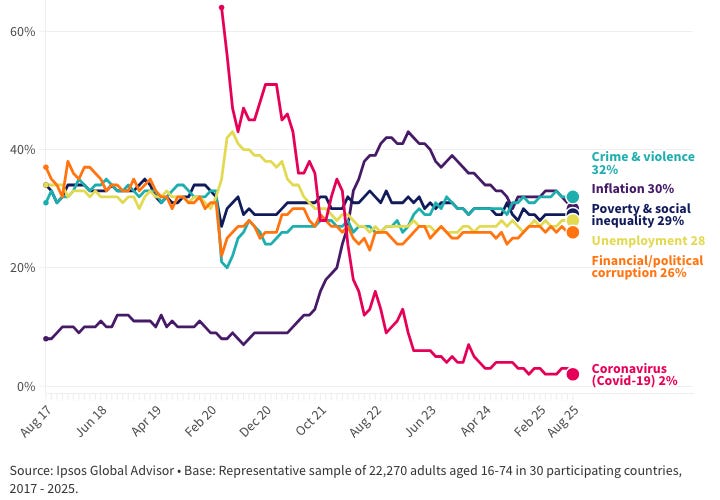This week…
Your reading time is about 5 minutes. Let’s start.
I am quite certain I have shared Widji Thukul’s poem Bunga dan Tembok here before. I don’t care. It’s one of my favourites. It’s pertinent. Tirani harus tumbang. Image is credit to @/mekitron on XTwitter, with translation.
I think this poem is a personal favourite because this is one of the few Bahasa Indonesia poems where I understood every word of every line (Bahasa Indonesia and Malay are mutually intelligible, but there are significant differences). The imagery is strong, the protest is loud, and the stubbornness is defiant.
Your Wikipedia this week: Orde baru
And now, a selection of top stories on my radar, a few personal recommendations, and the chart of the week.
ICYMI: The Previous Block was about “Margaux Blanchard,” the media and climate.
CORRECTION NOTICE: None notified.AI
Africa’s AI strongmen
Kwangu Liwewe and Alec D’Angelo for New Lines Magazine:
Burkina Faso’s interim president, Capt. Ibrahim Traoré, stands at a podium listing Africa’s riches. He names them as cobalt, platinum and uranium, and then asks why the continent, the world’s richest in minerals, remains poor. It’s a passionate speech about exploitation, corruption and neocolonialism. The speech is raw and defiant, its questions pertinent.
“Africa owns 70% of the world’s cobalt reserves. Your cellphones, your computer, your electric car won’t work without cobalt. This cobalt comes from Congo, but the Congolese can’t afford cellphones,” Traoré says.
“Gold flows like rivers from our lands, but our people swim in poverty,” he adds. Then comes the punch line: “Colonialism didn’t end, it changed shape. You used to come and occupy our lands, now you come and establish companies. You used to take by force, now you make agreements. You used to rule with the whip, now you rule with credit.”
It’s a fiery speech that sounds like Traoré — but it’s not real. The entire video was generated by artificial intelligence. Traoré never gave that speech. Still, it struck a nerve. Over 26 million people have watched and shared it. Some believe it’s authentic. Others don’t care. “If this is AI,” one viewer commented, “then let AI lead us.” Another posted: “He’s saying what every African leader is too scared to say.”
The speech is just one of numerous AI-generated videos flooding social media. And they’re not just political: They’re musical, visual and deeply emotional, and they feel real. On platforms like YouTube, TikTok and X, there’s a growing number of videos in which celebrities like Beyoncé, Buju Banton, R. Kelly, Chris Brown, Diddy and Burna Boy appear to sing Traoré’s praises in glowing terms. The music sounds eerily like the real artists. The vocals mimic their tone and cadence. The production quality is slick and the visuals are often overlaid with African flags, soldier salutes or protest imagery. But just like the political videos, the music and graphics are all AI-generated. These are not crude fakes. They’re realistic-looking deepfakes made to trigger strong emotions.
Loosely linked:
Fuelling the AGI hype: The recruitment playbook to land Big Tech contracts Marché Arends and Kathryn Cleary for Africa Uncensored.
How AI became the far right’s newest weapon against refugees by Anagha Nair for New Lines Magazine.
BBC reveals web of spammers profiting from AI Holocaust images by Kristina Völk and Kevin Nguyen for BBC.
Iceland has mostly avoided misinformation. That may be changing by Louis Jacobson for Poynter.
MEDIA
OSINT, aid flights and trusted contacts: how journalists are covering Gaza’s story from afar
Marina Adami for RISJ:
Foreign correspondents have long served as additional eyes on the ground, assisting local reporters in telling the story of conflicts around the world. Not in Gaza since October 2023.
That month marked the beginning of Israel’s offensive in response to the deadly attacks by Hamas and other armed groups. Over 20 months on, almost 200 Palestinian journalists have been killed by Israeli strikes, some have left, and international reporters are still not allowed inside the Strip.
As the world’s attention now coalesces around famine in war-torn Gaza, there are fewer journalists than ever able to report from the scene.
Those still on the ground are Gazan journalists who do their jobs while trying to survive amid hunger, displacement, and the threat of being targeted by the Israeli military. In early August, six Al Jazeera journalists were killed in a targeted attack on their tent. Five more were killed on Tuesday in a ‘double-tap’ attack on one of the biggest hospitals in Gaza.
Against this challenging backdrop, reporters outside the Strip are supplementing the work of Gazan journalists through a diverse range of reporting methods, to allow audiences to understand what’s happening in a territory mostly cut off from the outside world.
Some of these journalists are Gazans who were able to leave the Strip and continue their work from outside by relying on their knowledge and contacts. Others are open-source specialists who analyse footage, images and social media posts in an attempt to determine whether they show what they purport to, or international journalists making the most of whatever access they are allowed, joining aid drop flyovers and taking a look at the territory from above.
Loosely linked:
Journalism remains a lifeline in Gaza even as scores of reporters are killed by Hasan Jaber for The Globe and Mail.
Plestia Alaqad: ‘We were talking, applying for jobs. The next day, we woke up to a different reality’ by Benita Kolovos for The Guardian.
Final arguments conclude in Jimmy Lai national security trial in Hong Kong by Helen Davidson and HKFP for The Guardian.
SCIENCE
Bluesky now platform of choice for science community
Jennifer Oullette for Ars Technica:
Marine biologist and conservationist David Shiffman was an early power user and evangelist for science engagement on the social media platform formerly known as Twitter. Over the years, he trained more than 2,000 early career scientists on how to best use the platform for professional goals: networking with colleagues, sharing new scientific papers, and communicating with interested members of the public.
But when Elon Musk bought Twitter in 2022, renaming it X, changes to both the platform’s algorithm and moderation policy soured Shiffman on the social media site. He started looking for a viable alternative among the fledgling platforms that had begun to pop up: most notably Threads, Post, Mastodon, and Bluesky. He was among the first wave of scientists to join Bluesky and found that, even in its infancy, it had many of the features he had valued in “golden age” Twitter.
Shiffman also noticed that he wasn’t the only one in the scientific community having issues with Twitter. This impression was further bolstered by news stories in outlets like Nature, Science, and the Chronicle of Higher Education noting growing complaints about Twitter and increased migration over to Bluesky by science professionals.
A curious Shiffman decided to conduct a scientific survey, announcing the results in a new paper published in the journal Integrative and Comparative Biology. The findings confirm that, while Twitter was once the platform of choice for a majority of science communicators, those same people have since abandoned it in droves. And of the alternatives available, Bluesky seems to be their new platform of choice.
Loosely linked:
Research posts on Bluesky are more original — and get better engagement by Rachel Fieldhouse for Nature.
Why scientists are flocking to Substack by Hannah Docter-Loeb for Nature.
Other curious links, including en español et français

LONG READ | We failed the misinformation fight. Now what? by Zeve Sanderson and Scott Babwah Brennen for Noema.
PHOTO ESSAY | Journalist Mariam Dagga’s final images show where she was killed by an Israeli strike in Gaza by Edith M. Lederer and John Seewer for AP.
Denuncian infiltración de policías en grupos de prensa en Ecuador y crecen alertas por espionaje por Yalilé Loaiza en Infobae.
Los últimos (y controvertidos) días de Noroña en la tribuna del Senado por Micaela Varela en El País.
El sánscrito, la lengua tía del castellano que todavía hoy revela belleza y espíritu por Rafael del Moral en El Confidencial.
De nombreux jeunes à la recherche d’argent dans les jeux en ligne par Alphonsine Sefu dans Radio-Canada.
Le mythe de l’Éden numérique, ou quand la perfection vide l’âme par Jean-Paul Sabran dans Usbek & Rica.
Entre exil forcé et lenteur administrative par Oona Barrett dans Pivot.
What I read, listen, and watch
I’m reading Code Dependent (2024) by Madhumita Murgia. I am not sure if I have personally learned anything new from this book, having been following the AI news cycle nonstop, like stories about the people in Latin America andAafrica making pennies to sift through vast datasets, and discarded when no longer needed. I appreciated the fact that the author practically opened the book by stating that the voices warning about the human impacts of AI are almost always women of colour from outside the Western bubble.
I’m listening to Conspirituality about why Jillian Michaels is the ‘Biggest Loser.’ Guys, I have to admit — I had never made any of my partners past or present unfollow someone on social media. I always felt like that was controlling, insecure, and unhealthy. But the one time that I had made the wife unfollow someone was a few months ago when I found out she was following Jillian Michaels. I said, please, she is a quack!! It’s not jealousy or distrust! She said ew and unfollowed.
I’m watching Al Jazeera’s coverage of the unrest in Indonesia.
Chart of the week
Conducted monthly in 30 countries among around 20,000 adults for over a decade, the Ipsos What Worries the World study offers a snapshot of world opinion on pressing issues. More from this month here.




